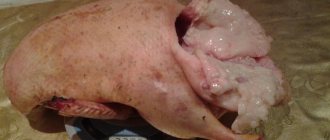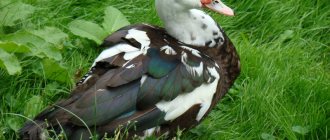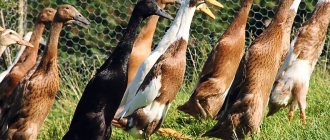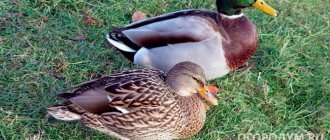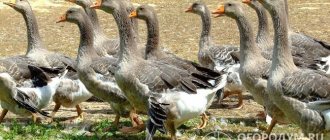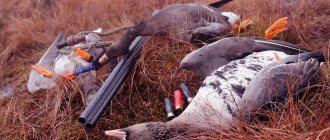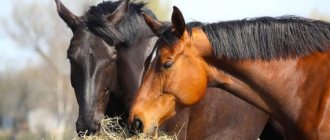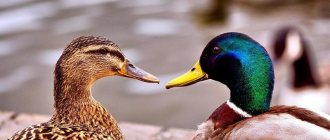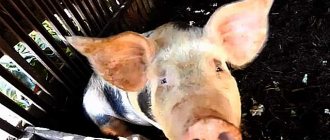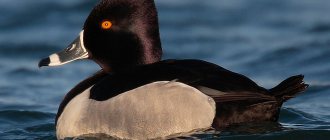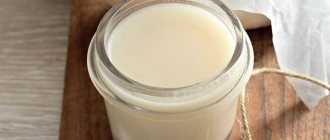The Murad duck breed is popularly called duck-goose due to its external similarity with both birds. They are easy to distinguish from other representatives of these birds: they are large, snow-white, and on the head, directly on the back of the head, there is a black spot. Quite often you can find birds with dark spots on their flapping wings. These large birds are bred exclusively for meat, and all grown and gained weight individuals are slaughtered. The latter is explained by the fact that mulards are sterile representatives of the duck family. In other words, they cannot have offspring and are not left for subsequent breeding. Duck-goose ducklings are born by crossing the Peking breed and the Indian duck.
This magnificent hybrid has attracted the attention of farmers due to its high meat productivity. Quite a bit of feed is spent on fattening, and the weight gain is impressive, especially if you use the forced feeding method: by 2-3 months the bird reaches slaughter condition, reaching 4-5 kilograms of live weight!
Description
Growing mulards brings good profits. They were obtained in France as a result of crossing Indo ducks and Peking ducks (Orpington or Allier can be used instead of the latter). The resulting hybrid gained popularity due to its rapid weight gain and high quality meat. The only negative is sterility. A hybrid breed does not produce offspring at home.
According to reviews, growing mulards is not difficult. Ducks are unpretentious and do not create noise in the poultry yard. They are clean, calm, can do without bodies of water, and do not strive for freedom.
The main color of ducks is white; there is always a black spot on the head. The presence of black feathers on the wings and tail is allowed. The bird's body is tightly knit and elongated. The tail is small and well developed. The neck is long, the head is oval, medium in size. The beak is elongated, flat, light in color. The eyes are dark. The legs are short and yellow. The wings are long. They are pressed tightly to the body.
What diseases are you susceptible to and how to avoid them?
Mulards are distinguished by good health and have innate immunity to many avian diseases. They withstand temperature changes and even slight frosts. When birds are well kept and fed properly, they hardly get sick. However, it cannot be said that the breed is absolutely not susceptible to harmful factors. Birds may suffer from the following disorders:
- Feather pecking. This problem is more common among mulards than others. It arises due to:
- poor diet (lack of drinking water, protein, shell rock or gravel);
- excessive amounts of bran and vegetables on the menu. They weaken the intestines, as a result of which important minerals are washed out of the body, and the bird gets sick;
- a cramped enclosure with no room to rest;
- insufficient number of drinkers and feeders.
- Aspergillosis. This is an infectious disease caused by a fungus. Infection occurs through the respiratory system when the pathogen is contained in stale food or moldy bedding. A few days after infection, the duck becomes lethargic and loses interest in food. At the same time, vomiting appears, heart rhythm and breathing are disturbed. The final stage of the disease is manifested by discharge from the beak and dysfunction of the limbs. If full veterinary care is not provided, the bird dies. A weak solution of copper sulfate and the human antifungal drug Nystatin are recommended as prophylactic agents;
- Cloacite. This is a direct consequence of vitamin deficiency. A new formation forms in the cloaca area, from which pus oozes. The bird can be helped by periodically washing the organ and then lubricating it with zinc ointment. Cloacitis, like other pathologies, is best treated in the early stages.
Productivity
Raising ducks of this breed pays off. In just 2-3 months they gain weight of 3.5-4 kg. Four-month-old individuals weigh 5-6 kg, depending on the quality of fattening. Due to their large dimensions, mulards are popularly called “ducks and geese”. Unlike other ducks, their meat is low in fat - the fat layer accounts for 3%. It does not have a specific taste. Females are not much smaller than males - the difference is about 500 g. An additional advantage of the hybrid is tasty liver. With proper fattening, its weight reaches 500-550 g. Ducks begin to lay eggs at the age of 180-210 days, and produce up to 220 eggs per year.
It is recommended to slaughter birds before molting occurs, which usually occurs on the seventieth day of life. When changing plumage, ducks lose weight, feather stumps remain on the body, which affects the quality of the carcasses. If the deadline is missed, you need to wait about a month.
You can speed up the slaughter period by raising ducks in cages - by the age of one and a half months they gain sufficient weight for this. The main disadvantage of this content is that the meat becomes fatty.
Performance
Mulards stand out from other bird breeds due to their rapid weight gain. So, at the age of two months their weight reaches almost four kilograms. Moreover, such a mass is typical not only for males; females are only 0.5 kg inferior in performance.
Special diets and husbandry methods make it possible to produce drakes weighing up to 6 kg within 90 days. To do this, they are raised in cramped cages where there is no way to stand on their feet. Most of the feed is corn. But such metrics will require a significant investment of time and resources.
Mulard's liver - the famous foie gras
In addition to delicious dietary meat, about which there are so many reviews, mulards are valued for their liver. In France, they are grown to produce tasty, fatty liver for the delicacy foie gras.
Previously, geese were used for this purpose, but this breed of duck requires less time to obtain results.
As mentioned above, Mulard ducks are not capable of breeding, so they are not suitable for raising for eggs. To be fair, it is worth noting that at times drakes cover ducks, sometimes they even lay eggs, but they are not fertilized.
Breeding at home
To raise mulards at home, they purchase hatching eggs or ducklings - when breeding within the herd, it will not be possible to obtain offspring due to the sterility of the individuals. You can independently breed productive hybrids by crossing:
- drake musk duck and female Peking breed;
- male Pekingese breed and Indian ducks.
In any of the options, the family consists of one breeder and three to six females.
When forming a family, it is worth considering that Pekin ducks rarely hatch their offspring, while Indian ducks become excellent hens.
For mating, sexually mature females and strong males who have reached the age of at least 9-10 months are selected. The best period for dividing into families is mid-spring. The birds will need some time to adapt.
Each family is allocated a separate pen - at least 1 square meter per individual. m. Prepare nests (one for 3 females) and install them in a shaded, quiet place. The diameter of the bottom is about 40 cm. A layer of straw is placed inside and the litter is kept clean.
From the moment egg laying begins, eggs are collected regularly and a dummy is left in the nest. If this is not done, the duck may look for another place to lay. Specimens suitable for incubation are stored in a cool room. Optimal temperature for maintaining productive qualities: +12°C. Humidity – 70%. The choice for incubation is carried out according to the following criteria:
- smooth shell without sagging;
- correct form;
- average weight (about 80 g);
- no cracks or heavy contamination.
The eggs are turned daily to prevent the yolk from moving. Before laying, they are stored for no longer than ten days, after which the hatchability percentage drops.
Before being placed in an incubator or in a brood nest, eggs are checked for internal defects using an ovoscope. There should be no microcracks, displacement of the air sac, double or displaced yolk, or foreign inclusions.
Types of feed used
Food is usually given to waterfowl in the form of wet mash. The diet of such a bird must include food:
- juicy;
- concentrated.
The best succulent food for geese and ducks are:
- beet;
- swede;
- turnip;
- potato.
Also, waterfowl often include food of animal origin in their diet:
- fish;
- return;
- buttermilk.
Barley grain is the best concentrate for ducks and geese. Also, in small quantities, such birds can be offered wheat and, in some cases, rye. In addition to grain, peas and corn are often used from concentrates to feed such animals in farmsteads.
Hatching chicks
At home, mulard ducks are raised by placing eggs under the hen or placing them in an incubator.
Breeding in the nest
If a duck sits on a clutch, it can hatch 15-20 eggs, depending on its size (all eggs must be covered). The yield percentage is high - on average, no more than two eggs are lost from a clutch (minimum yield - 80%). The hen is provided with water and food.
Incubation
When using an incubator, the hatching percentage is lower - about 65%. Before laying eggs, the shells are disinfected with a pink solution of potassium permanganate. Optimal liquid temperature: +30°C. They are kept in the solution for 3 minutes, after which they are laid out on a clean cloth. If there are stains, carefully rub them off with a soft toothbrush, sponge or cloth.
Before being placed in the incubator, the eggs are transferred from a cool room to a warm one so that they warm up to room temperature. Each specimen is marked on opposite sides to control overturning. When laying horizontally, the rotation is performed 180 degrees, when laying vertically - 45. Incubation takes 31 days. Recommended settings:
| Duration (days) | Humidity (%) | Temperature (°C) | Cooling | Turn |
| 1-3 | 75 | +37.6 | – | 4-6 |
| 4-7 | 75 | +37.4 | – | 4-6 |
| 8-16 | 62 | +37.4 | – | 4-6 |
| 17 | 62 | +37.3 | – | 4-6 |
| 18-21 | 55 | +37.3 | 2 times a day for 15-20 minutes | 4-6 |
| 22-24 | 50 | +37.2 | 2 times a day for 15-20 minutes | 4-6 |
| 25-28 | 50 | +37.1 | 2 times a day for 15-20 minutes | 4-6 |
| 29 | 67 | +37 | – | – |
| 30 | 75 increasing to 85 | +36.8 | – | – |
| 31 | 85 | +36.7 | – | – |
As the eggs cool, sprinkle them with water. During the incubation process, the clutch is checked three times using an ovoscope to reject unfertilized specimens and those where death or disruption of embryo development is observed. Approximate dates: seventh, sixteenth and twenty-fifth days.
From the moment of pecking, hatching takes about a day. The dried young animals are transferred to a brooder. At the first stage, the bottom is covered with paper and changed regularly.
Raising and feeding ducklings
Small Mulard ducks are kept in a brooder for the first three weeks, after which they are transferred to floor housing. The room should be warm and draft-free. The floor is covered with hay or straw. Peat and sawdust are contraindicated because chicks mistake them for food.
Temperature and lighting
At the first stage, stocking density: up to 16 heads per 1 sq. m. The temperature under the heater is gradually adjusted:
- up to a week of age it is maintained at +28…+30°C;
- by two weeks of age, it is gradually, day by day, reduced to +23°C;
- three-week-old chicks are kept at +20°C (heating is not required in summer).
Air humidity – 65-70%. Drafts are contraindicated, but air ventilation is required. The place where ducklings are kept is constantly cleared of debris and equipment is washed. From the age of two weeks, the chicks begin to be released for walks in good weather - the temperature should not be lower than +20°C. At one month of age, young animals can be placed in a common poultry house, but in a pen separate from the adults.
Up to a week of age, the duration of illumination is 20 hours, intensity is 2-4 W/sq.m. During rest periods, the light is not turned off completely, but the brightness is reduced to 1-2 W/sq.m. From the second week, the duration of illumination is reduced weekly by 60 minutes, ultimately bringing it to sixteen hours.
Feeding the young
Ready-made mixed feed or self-prepared mash is suitable for feeding young animals. When preparing the latter, a mixture of boiled eggs and corn, wheat or oatmeal is used. If the chicks are not interested in food, then you can sprinkle a little on their backs - the moving food attracts attention and the ducklings begin to peck at it.
On the third day, add chopped grass (alfalfa, clover, nettle), sour milk, cottage cheese. Gradually the diet is expanded, they begin to give vegetables, meal, bone meal, feed yeast, duckweed, bran, and legumes. From the tenth day, the egg is removed and gravel is poured into separate containers. Mandatory feed components:
- chalk - from 0.1 to 0.5 g, the rate is gradually increased until three weeks of age;
- shell, ground shell - from 0.5 to 3 g, depending on age.
Birds are given dry and wet food - the mash has a crumbly consistency and cannot be stored for longer than an hour. Drinkers should always be filled with water. The frequency of feedings is reduced gradually - at first, ducklings are fed every 2 hours, by the age of one month, 3 feedings are left.
Birdhouse for waterfowl
In most cases, a barn for any breed of ducks and geese is built of a panel or cobblestone structure. Such buildings are cool in summer and quite warm in winter. A poultry house for waterfowl should have a large area. Chickens, for example, can be housed in a barn in perches at different levels. In most cases, geese and ducks in private farmsteads are kept on the floor. If there is a lot of crowding, and without the ability to find an individual place, such a bird will experience severe stress, which will have a very negative impact on its health and productivity.
No more than 1-2 geese and 3 ducks are allowed per 1 m2 of waterfowl shed. The height of the poultry house for such birds should be approximately 2.1 m. This will save on heating the structure in winter.
Of course, a barn for waterfowl should also have windows for lighting and ventilation. Straw is usually laid on the floor in such a poultry house. Ideally, the thickness of the bedding in the barn should be 40-50 cm. In this case, the waste products of the bird will rot naturally, and they will not have to be constantly cleaned. In winter, such bedding will become an additional natural source of heating for the shed.
Fattening Mulard ducks
When raised for meat, it is better to use complete feed for waterfowl - they contain all the necessary components.
When independently preparing a feed mixture for one-month-old young animals, the following is added to its composition:
- crushed grain (corn, wheat, barley) – 80-100 g;
- grain waste – 30-40 g;
- wheat bran – 35-40 g;
- meal and cake – 15-20 g;
- yeast – 1 g;
- shell – 5-6 g;
- bone meal – 2-3 g;
- salt – 1 g;
- gravel – 2 g.
Add to the wet mixture:
- boiled potatoes and other vegetables (60-80 g);
- grass – 70-80 g;
- meat and fish waste – 20-25 g.
While walking, birds receive additional nutrition - they eat duckweed, grass, and insects.
When raising mulard ducks on the liver, they are limited in movement and force-fed through a funnel. At home, corn becomes the main component of nutrition - it gives the product an appetizing color and ensures rapid weight gain.
The best breeds of geese
Very extensive selection work was also carried out with such waterfowl. The most popular breeds of geese at the moment are:
- Kholmogory;
- large gray ones;
- Legards.
The weight of drake geese of the Kholmogory breed can reach 12 kg, and that of geese - 8 kg. This bird, among other things, is distinguished by its early maturity, resistance to various kinds of diseases, and calm character. Large gray geese can reach a weight of 9.5 kg by the age of 9 weeks. Moreover, such a bird lays about 60 eggs per year.
Legarda geese with proper diet gain weight of 9-11 kg. This bird is also distinguished by its good early maturity and peaceful character.
